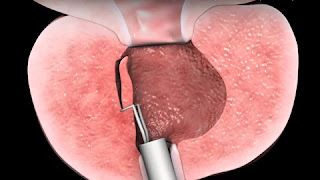PROSTATE ENLARGEMENT / புரோஸ்டேட் வீக்கம்
__________________________________________________
இக்கட்டுரை கூகுள் மொழிபெயர்ப்புக் கருவி மூலம் உருவாக்கப்பட்டது.
This article was translated by the help of Google Translate.
PROSTATE ENLARGEMENT / புரோஸ்டேட் வீக்கம்
ஆண்களிடம் இருக்கும்
மிகவும் மென்மையான
ஒரு பகுதி தான்
புரோஸ்டேட் சுரப்பி.
ஆண்களுக்கு வயது
அதிகரிக்கும் போது,
பெரும்பாலானோருக்கு புரோஸ்டேட்
சுரப்பியில் பிரச்சனைகளானது ஏற்படக்கூடும். எனவே
இந்த சுரப்பியின் ஆரோக்கியத்தை
பாதுகாக்கும் பணியின்
ஆண்கள் உடனே ஈடுபட
வேண்டும். இல்லாவிட்டால் பிற்காலத்தில் பெரும்
பிரச்சனைக்கு ஆளாகக்கூடும்.
பொதுவாக வயதான
பின் ஆண்கள் சந்திக்கும்
பிரச்சனைகளில் ஒன்று
தான் புரோஸ்டேட் வீக்கம்.
இத்தகைய புரோஸ்டேட்
வீக்கம் ஏற்படாமல்
இருக்க வேண்டுமானால், இன்றிலிருந்தே அதன் ஆரோக்கியத்தை
பாதுகாத்து வாருங்கள்.
அதுமட்டுமின்றி, தற்போது
புரோஸ்டேட் புற்றுநோயும்
ஆண்களை தாக்கி வருகிறது.
இந்த புற்றுநோய் வருவதற்கு
மன அழுத்தம், ஆரோக்கியமற்ற
வாழ்க்கை முறை
மற்றும் சில
கெட்ட பழக்கங்களும் தான்
முக்கிய காரணங்களாக
உள்ளன.
மேலும் புரோஸ்டேட் சுரப்பியானது
சிறுநீரகத்திற்கு அருகில்
இருப்பதால், ஆண்கள்
சரியாக சிறுநீர் கழிக்காவிட்டாலோ அல்லது சிறுநீரகத்தின் ஆரோக்கியத்தைப் முறையாக
பேணி பாதுக்காக்காவிட்டாலோ, புரோஸ்டேட்
வீக்கமானது ஏற்படும்.
இப்படி வீக்கம் ஏற்பட்டால்
கடுமையான வலியை
அனுபவிப்பதுடன், எப்போதும்
அசௌகரியமாக இருக்கக்கூடும். ஆகவே புரோஸ்டேட்
சுரப்பியில் எவ்விரத
பிரச்சனையும் ஏற்படாமல்
இருக்க வேண்டுமானால், ஆண்கள்
அதன் ஆரோக்கியத்தைப் பாதுகாக்கும்
பணியின் இன்றில்
இருந்தே ஈடுபட
வேண்டும். இங்கு
புரோஸ்டேட் சுரப்பியை
என்னவெல்லாம் செய்து
வந்தால் பாதுகாக்க
முடியும் என்பதைப்
பார்ப்போம்.
மொபைல் கதிர்வீச்சு பெரும்பாலான ஆண்கள் தங்களின் மொபைல் போன்களை பேண்ட் பாக்கெட்டில் வைத்துக் கொள்கிறார்கள். இது ஆண்களின் பிறப்புக்களுக்கு மிகவும் ஆபத்தானது. ஏனெனில் மொபைல் போனில் இருந்து வெளிவரும் கதிர்வீச்சுக்களானது, புரோஸ்டேட் புற்றுநோயை தூண்டக்கூடியவை.
சரியான
உள்ளாடை
அதிகப்படியான வெப்பம்
ஆண்விதைகளுக்கு நல்லதல்ல.
மேலும் புரோஸ்டேட் சுரப்பியானது
சிறுநீர்ப்பைக்கு கீழே
வலது பக்கத்தில் உள்ளது.
எனவே இறுக்கமான உள்ளாடையை
அணிந்தால், புரோஸ்டேட்
சுரப்பியானது அதிக
அழுத்தத்திற்கு உட்படுவதுடன்,
வெப்பமடைந்துவிடும். ஆகவே
எப்போதும் தளர்வான
உள்ளாடையை அணிய
வேண்டும்.
போதிய தண்ணீர்
தினமும்
அதிக அளவில் தண்ணீர்
குடித்து, சிறுநீரை
வெளியேற்ற வேண்டும்.
ஒருவேளை அபபடி
தண்ணீர் குடிக்காமல்,
சிறுநீர் கழிக்காமல்
அப்படியே இருந்தால்,
சிறுநீரக தசைகளானது
இறுக்கமடைய ஆரம்பித்துவிடும். பின் அடிக்கடி
சிறுநீர் வருவது
போன்ற உணர்வுகள் இருக்கும்,
ஆனால் சிறுநீர் வெளியேறாமல்,
உடலில் நச்சுக்கள் அதிகரித்து,
புரோஸ்டேட் ஆரோக்கியத்தைப் பாதிக்கும்.
புகைப்பிடிப்பதை நிறுத்தவும் ஆண்களுக்கு இருக்கும்
ஒரு முக்கியமான கெட்ட
பழக்கம் தான்
புகைப்பிடிப்பது. இப்படி
ஒன்று தானே என்று
தினமும் ஒரு
சிகரெட் பிடித்து
வந்தாலே, பிற்காலத்தில் புரோஸ்டேட் புற்றுநோயால்
அவஸ்தைப்படக்கூடும்.
ஜிங்க்
நிறைந்த உணவுகளை
உட்கொள்ளவும் ஆண்களில் உடலில்
உள்ள டெஸ்டோஸ்டிரோனின் அளவை
சீராக வைத்துக் கொள்ள
ஜிங்க் மிகவும் இன்றியமையாதது. அதிலும் ஆண்களுக்கு
வயதாகும் டெஸ்டோஸ்டிரோனின் அளவு குறைவதால்,
புரோஸ்டேட் சுரப்பியானது
வீக்கமடைய ஆரம்பிக்கும்.
எனவே ஆண்கள் எப்போதும்
ஜிங்க் நிறைந்த உணவுகளை
அன்றாடம் எடுத்து
வர வேண்டும்.
உள்ளாடை அணிவதை
தவிர்க்க வேண்டாம் சிலர்
பேண்ட், ஜீன்ஸ் அணியும்
போது உள்ளாடை அணியமாட்டார்கள். அப்படி அணியாமல்
இருந்தால், பேண்ட்
அல்லது ஜீன்ஸானது அதிகப்படியான
அழுத்தத்தைக் கொடுத்து,
புரோஸ்டேட் சுரப்பியை
பாதிப்பிற்குள்ளாக்கும். இப்படியே
நீடித்தால், நாளடைவில்
புரோஸ்டேட் சுரப்பியில்
வீக்கமானது ஏற்படக்கூடும்.
பச்சை பூண்டு
சாப்பிடவும் பூண்டில் அல்லியம்
என்னும் பொருள்
அதிகம் உள்ளது. இது
புரோஸ்டேட் புற்றுநோய்
வருவதை 20 சதவீதம் குறைக்கும்.
எனவே தினமும் ஒரு
பல் பூண்டை பச்சையாக
சாப்பிடுங்கள்.
உலர்ந்த கற்பூரவள்ளி (Oregano) உலர்ந்த கற்பூரவள்ளியில் ஆன்டி-கேன்சர் பொருள் அதிகம் இருப்பதால், இதனை
உணவில்
சேர்த்து வந்தால், புற்றுநோயை உண்டாக்கும் செல்களை இவை
அழித்துவிடும். மேலும்
இது
புரோஸ்டேட் செல்களுக்கு மிகவும் சிறந்தது.
பைஜியம்
(Pygeum) இது ஒரு ஆப்பிரிக்கா
ப்ளம்ஸ். இது
புரோஸ்டேட் வீக்கம்
இருந்தால், அதனை
குணப்படுத்த உதவும்.
அதிலும் இதனை
டீ செய்தோ அல்லது
வேறு எந்த விதத்திலோ
உணவில் சேர்த்துக் கொள்வது
நல்லது.
Treatment Options
Trans Urethral Resection of the Prostate – (TURP) A TURP is an operation done with a telescope through the water passage to shell out the prostate gland and relieve symptoms of obstruction. The operation takes about 40 minutes – 1 hour. In most cases the enlargement is benign (not cancer), but occasionally the enlargement may be due to cancer. Your doctor will be able to tell you if cancer is suspected, however the doctor may not be sure until the prostate tissue is examined by the pathologist after the operation.
Laser Prostate Surgery Similar to traditional transurethral resection of the prostate (TURP), laser prostatectomy is performed when benign prostatic enlargement causes symptomatic partial obstruction of the bladder outlet. Various lasers are used for this purpose but all have the same goal, which is to remove obstructing prostate tissue, thus creating an open channel for urine to pass freely through the remaining prostate. Urologists at AUA are trained and experienced in photovaporisation of the prostate (PVP) using the Greenlight™ laser. Under spinal or general anaesthetic, a telescope is passed into the urethra to the level of the prostate, which sits directly beneath the bladder and surrounds its outlet. In a traditional TURP, an electrified loop of wire is passed through the scope and swept through the prostate, cutting away chips of prostate tissue. Although the loop is able to cauterize tissue as well, there is always some degree of bleeding. In PVP using the Greenlight™ laser, a laser fibre is instead passed and fired at the obstructing prostate tissue, instantly vaporizing the tissue and simultaneously cauterizing it. PVP results in minimal bleeding which enables patients to undergo the procedure as a day admission or overnight stay. A catheter is left in the urethra to drain the bladder overnight and is removed the next day. Although PVP can be used for most patients with benign enlargement of the prostate, its main advantage lies with patients with cardiovascular disease who require ongoing anticoagulation, or “blood thinning”.
Prostatitis indicates inflammation of the prostate and covers a whole spectrum of clinical entities. It is not always due to infection and does not always cause symptoms. At one end of the spectrum is acute bacterial prostatitis, which presents with fever, feeling acutely unwell and sudden difficulty urinating. This is a medical emergency, requiring intravenous antibiotics and drainage of the bladder via a catheter. At the other end of the spectrum is chronic non-bacterial prostatitis, characterized by pain in the pelvic area. It is often not certain whether these symptoms are due to prostatitis at all, and is now termed chronic pelvic pain syndrome. Such symptoms may be relieved by treatments such as anti-inflammatory medication or pelvic physiotherapy. In addition, sometimes prostatitis is diagnosed on a prostate biopsy without the patient having any symptoms at all. Like BPH and prostate cancer, prostatitis can also elevate the PSA, as well as cause it to fluctuate.












Comments
Post a Comment